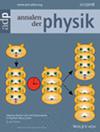求助PDF
{"title":"二维V2CS2、Cr2CS2和Mn2CS2中多拓扑相和高阶拓扑共存的研究","authors":"Jie Du, Guilin Lu, Tao Zhu, Yong Jiang, Wenhong Wang","doi":"10.1002/andp.202400413","DOIUrl":null,"url":null,"abstract":"<p>This study investigates the topological properties of 2D <span></span><math>\n <semantics>\n <mrow>\n <msub>\n <mi>V</mi>\n <mn>2</mn>\n </msub>\n <msub>\n <mi>CS</mi>\n <mn>2</mn>\n </msub>\n </mrow>\n <annotation>${\\rm V}_2{\\rm CS}_2$</annotation>\n </semantics></math>, <span></span><math>\n <semantics>\n <mrow>\n <msub>\n <mi>Cr</mi>\n <mn>2</mn>\n </msub>\n <msub>\n <mi>CS</mi>\n <mn>2</mn>\n </msub>\n </mrow>\n <annotation>${\\rm Cr}_2{\\rm CS}_2$</annotation>\n </semantics></math>, and <span></span><math>\n <semantics>\n <mrow>\n <msub>\n <mi>Mn</mi>\n <mn>2</mn>\n </msub>\n <msub>\n <mi>CS</mi>\n <mn>2</mn>\n </msub>\n </mrow>\n <annotation>${\\rm Mn}_2{\\rm CS}_2$</annotation>\n </semantics></math> using first-principles calculations. The rare coexistence of different topological fermion types is uncovered within single materials: <span></span><math>\n <semantics>\n <mrow>\n <msub>\n <mi>V</mi>\n <mn>2</mn>\n </msub>\n <msub>\n <mi>CS</mi>\n <mn>2</mn>\n </msub>\n </mrow>\n <annotation>${\\rm V}_2{\\rm CS}_2$</annotation>\n </semantics></math> hosts both type-I and type-II Dirac points, while the spin-down channel of ferromagnetic <span></span><math>\n <semantics>\n <mrow>\n <msub>\n <mi>Cr</mi>\n <mn>2</mn>\n </msub>\n <msub>\n <mi>CS</mi>\n <mn>2</mn>\n </msub>\n </mrow>\n <annotation>${\\rm Cr}_2{\\rm CS}_2$</annotation>\n </semantics></math> exhibits both type-I and type-II Weyl points. In contrast, <span></span><math>\n <semantics>\n <mrow>\n <msub>\n <mi>Mn</mi>\n <mn>2</mn>\n </msub>\n <msub>\n <mi>CS</mi>\n <mn>2</mn>\n </msub>\n </mrow>\n <annotation>${\\rm Mn}_2{\\rm CS}_2$</annotation>\n </semantics></math> is identified as an antiferromagnetic insulator (gap <span></span><math>\n <semantics>\n <mo>∼</mo>\n <annotation>$\\sim$</annotation>\n </semantics></math>375 meV), and the spin-up channel of <span></span><math>\n <semantics>\n <mrow>\n <msub>\n <mi>Cr</mi>\n <mn>2</mn>\n </msub>\n <msub>\n <mi>CS</mi>\n <mn>2</mn>\n </msub>\n </mrow>\n <annotation>${\\rm Cr}_2{\\rm CS}_2$</annotation>\n </semantics></math> is insulating (gap <span></span><math>\n <semantics>\n <mo>∼</mo>\n <annotation>$\\sim$</annotation>\n </semantics></math>28 meV). We demonstrate that biaxial strain can tune the fermion topology, transforming type-II into type-III fermions, while type-I fermions remain robust. Spin-orbit coupling (SOC) induces gaps at type-I points (<span></span><math>\n <semantics>\n <mo>∼</mo>\n <annotation>$\\sim$</annotation>\n </semantics></math>20-24 meV) but leaves type-II fermions gapless, indicating their robustness against SOC. Furthermore, the spin-up channel of <span></span><math>\n <semantics>\n <mrow>\n <msub>\n <mi>Cr</mi>\n <mn>2</mn>\n </msub>\n <msub>\n <mi>CS</mi>\n <mn>2</mn>\n </msub>\n </mrow>\n <annotation>${\\rm Cr}_2{\\rm CS}_2$</annotation>\n </semantics></math> and <span></span><math>\n <semantics>\n <mrow>\n <msub>\n <mi>Mn</mi>\n <mn>2</mn>\n </msub>\n <msub>\n <mi>CS</mi>\n <mn>2</mn>\n </msub>\n </mrow>\n <annotation>${\\rm Mn}_2{\\rm CS}_2$</annotation>\n </semantics></math> is identified as magnetic high-order topological insulators (HOTIs). This is confirmed by calculations of quantized fractional corner charges (e/3) protected by <span></span><math>\n <semantics>\n <msub>\n <mi>C</mi>\n <mn>3</mn>\n </msub>\n <annotation>${\\rm C}_3$</annotation>\n </semantics></math> symmetry and the identification of topological corner states using tight-binding models. These findings reveal a rich topological landscape in these materials, offering potential for fundamental research and applications in spintronics and quantum computing.</p>","PeriodicalId":7896,"journal":{"name":"Annalen der Physik","volume":"537 8","pages":""},"PeriodicalIF":2.5000,"publicationDate":"2025-06-11","publicationTypes":"Journal Article","fieldsOfStudy":null,"isOpenAccess":false,"openAccessPdf":"","citationCount":"0","resultStr":"{\"title\":\"Coexistence of Multiple Topological Phases and High-Order Topology in 2D V2CS2, Cr2CS2, and Mn2CS2\",\"authors\":\"Jie Du, Guilin Lu, Tao Zhu, Yong Jiang, Wenhong Wang\",\"doi\":\"10.1002/andp.202400413\",\"DOIUrl\":null,\"url\":null,\"abstract\":\"<p>This study investigates the topological properties of 2D <span></span><math>\\n <semantics>\\n <mrow>\\n <msub>\\n <mi>V</mi>\\n <mn>2</mn>\\n </msub>\\n <msub>\\n <mi>CS</mi>\\n <mn>2</mn>\\n </msub>\\n </mrow>\\n <annotation>${\\\\rm V}_2{\\\\rm CS}_2$</annotation>\\n </semantics></math>, <span></span><math>\\n <semantics>\\n <mrow>\\n <msub>\\n <mi>Cr</mi>\\n <mn>2</mn>\\n </msub>\\n <msub>\\n <mi>CS</mi>\\n <mn>2</mn>\\n </msub>\\n </mrow>\\n <annotation>${\\\\rm Cr}_2{\\\\rm CS}_2$</annotation>\\n </semantics></math>, and <span></span><math>\\n <semantics>\\n <mrow>\\n <msub>\\n <mi>Mn</mi>\\n <mn>2</mn>\\n </msub>\\n <msub>\\n <mi>CS</mi>\\n <mn>2</mn>\\n </msub>\\n </mrow>\\n <annotation>${\\\\rm Mn}_2{\\\\rm CS}_2$</annotation>\\n </semantics></math> using first-principles calculations. The rare coexistence of different topological fermion types is uncovered within single materials: <span></span><math>\\n <semantics>\\n <mrow>\\n <msub>\\n <mi>V</mi>\\n <mn>2</mn>\\n </msub>\\n <msub>\\n <mi>CS</mi>\\n <mn>2</mn>\\n </msub>\\n </mrow>\\n <annotation>${\\\\rm V}_2{\\\\rm CS}_2$</annotation>\\n </semantics></math> hosts both type-I and type-II Dirac points, while the spin-down channel of ferromagnetic <span></span><math>\\n <semantics>\\n <mrow>\\n <msub>\\n <mi>Cr</mi>\\n <mn>2</mn>\\n </msub>\\n <msub>\\n <mi>CS</mi>\\n <mn>2</mn>\\n </msub>\\n </mrow>\\n <annotation>${\\\\rm Cr}_2{\\\\rm CS}_2$</annotation>\\n </semantics></math> exhibits both type-I and type-II Weyl points. In contrast, <span></span><math>\\n <semantics>\\n <mrow>\\n <msub>\\n <mi>Mn</mi>\\n <mn>2</mn>\\n </msub>\\n <msub>\\n <mi>CS</mi>\\n <mn>2</mn>\\n </msub>\\n </mrow>\\n <annotation>${\\\\rm Mn}_2{\\\\rm CS}_2$</annotation>\\n </semantics></math> is identified as an antiferromagnetic insulator (gap <span></span><math>\\n <semantics>\\n <mo>∼</mo>\\n <annotation>$\\\\sim$</annotation>\\n </semantics></math>375 meV), and the spin-up channel of <span></span><math>\\n <semantics>\\n <mrow>\\n <msub>\\n <mi>Cr</mi>\\n <mn>2</mn>\\n </msub>\\n <msub>\\n <mi>CS</mi>\\n <mn>2</mn>\\n </msub>\\n </mrow>\\n <annotation>${\\\\rm Cr}_2{\\\\rm CS}_2$</annotation>\\n </semantics></math> is insulating (gap <span></span><math>\\n <semantics>\\n <mo>∼</mo>\\n <annotation>$\\\\sim$</annotation>\\n </semantics></math>28 meV). We demonstrate that biaxial strain can tune the fermion topology, transforming type-II into type-III fermions, while type-I fermions remain robust. Spin-orbit coupling (SOC) induces gaps at type-I points (<span></span><math>\\n <semantics>\\n <mo>∼</mo>\\n <annotation>$\\\\sim$</annotation>\\n </semantics></math>20-24 meV) but leaves type-II fermions gapless, indicating their robustness against SOC. Furthermore, the spin-up channel of <span></span><math>\\n <semantics>\\n <mrow>\\n <msub>\\n <mi>Cr</mi>\\n <mn>2</mn>\\n </msub>\\n <msub>\\n <mi>CS</mi>\\n <mn>2</mn>\\n </msub>\\n </mrow>\\n <annotation>${\\\\rm Cr}_2{\\\\rm CS}_2$</annotation>\\n </semantics></math> and <span></span><math>\\n <semantics>\\n <mrow>\\n <msub>\\n <mi>Mn</mi>\\n <mn>2</mn>\\n </msub>\\n <msub>\\n <mi>CS</mi>\\n <mn>2</mn>\\n </msub>\\n </mrow>\\n <annotation>${\\\\rm Mn}_2{\\\\rm CS}_2$</annotation>\\n </semantics></math> is identified as magnetic high-order topological insulators (HOTIs). This is confirmed by calculations of quantized fractional corner charges (e/3) protected by <span></span><math>\\n <semantics>\\n <msub>\\n <mi>C</mi>\\n <mn>3</mn>\\n </msub>\\n <annotation>${\\\\rm C}_3$</annotation>\\n </semantics></math> symmetry and the identification of topological corner states using tight-binding models. These findings reveal a rich topological landscape in these materials, offering potential for fundamental research and applications in spintronics and quantum computing.</p>\",\"PeriodicalId\":7896,\"journal\":{\"name\":\"Annalen der Physik\",\"volume\":\"537 8\",\"pages\":\"\"},\"PeriodicalIF\":2.5000,\"publicationDate\":\"2025-06-11\",\"publicationTypes\":\"Journal Article\",\"fieldsOfStudy\":null,\"isOpenAccess\":false,\"openAccessPdf\":\"\",\"citationCount\":\"0\",\"resultStr\":null,\"platform\":\"Semanticscholar\",\"paperid\":null,\"PeriodicalName\":\"Annalen der Physik\",\"FirstCategoryId\":\"101\",\"ListUrlMain\":\"https://onlinelibrary.wiley.com/doi/10.1002/andp.202400413\",\"RegionNum\":4,\"RegionCategory\":\"物理与天体物理\",\"ArticlePicture\":[],\"TitleCN\":null,\"AbstractTextCN\":null,\"PMCID\":null,\"EPubDate\":\"\",\"PubModel\":\"\",\"JCR\":\"Q2\",\"JCRName\":\"PHYSICS, MULTIDISCIPLINARY\",\"Score\":null,\"Total\":0}","platform":"Semanticscholar","paperid":null,"PeriodicalName":"Annalen der Physik","FirstCategoryId":"101","ListUrlMain":"https://onlinelibrary.wiley.com/doi/10.1002/andp.202400413","RegionNum":4,"RegionCategory":"物理与天体物理","ArticlePicture":[],"TitleCN":null,"AbstractTextCN":null,"PMCID":null,"EPubDate":"","PubModel":"","JCR":"Q2","JCRName":"PHYSICS, MULTIDISCIPLINARY","Score":null,"Total":0}
引用次数: 0
引用
批量引用


 求助内容:
求助内容: 应助结果提醒方式:
应助结果提醒方式:


